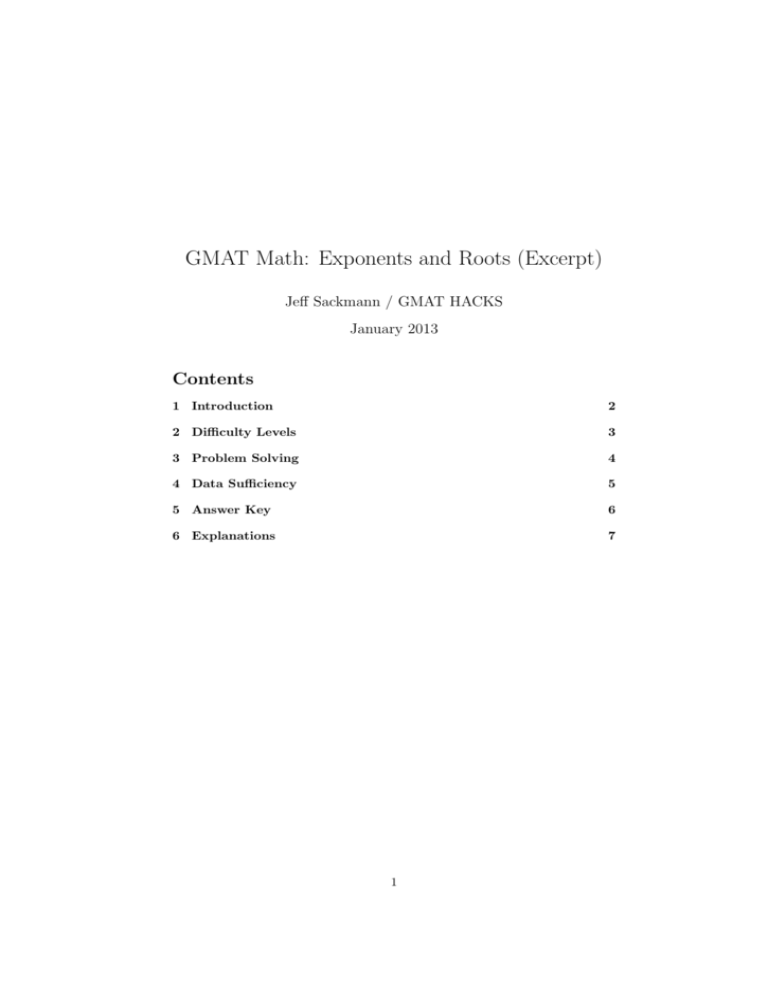GMAT Math: Exponents and Roots (Excerpt)
advertisement

GMAT Math: Exponents and Roots (Excerpt) Jeff Sackmann / GMAT HACKS January 2013 Contents 1 Introduction 2 2 Difficulty Levels 3 3 Problem Solving 4 4 Data Sufficiency 5 5 Answer Key 6 6 Explanations 7 1 Jeff Sackmann www.gmathacks.com 1 Introduction This document contains nothing but GMAT Exponents and Roots questions– 100 of them, to be exact. While most questions in this category rely on a few basic rules, many test-takers don’t know those rules, and the harder questions make it difficult to recognize how to apply them. As in all of my GMAT preparation resources, you’ll find these questions indexed by difficulty. That doesn’t mean you should skip straight to the hardest questions, or even that you should start with the easier ones. On the GMAT itself, questions won’t come labeled with their difficulty level, and despite the intent of the adaptive algorithm, they won’t be precisely consistent in terms of difficulty either. Each question presents its own unique challenges, and the sooner you get accustomed to changing gears with every single question, the more time you’ll have to prepare for that particular challenge of the exam. For further practice, I have produced several other resources that may help you. Several of my 100-question practice sets include a fair amount of content that covers Exponents and Roots, including ”Number Properties: Challenge,” ”Data Sufficiency: Challenge,” and ”Algebra: Challenge.” Eventually, you’ll start seeing questions that look familiar. That’s a good thing: there are only so many ways the GMAT can test these concepts, and if you’ve done a few hundred Exponents and Roots questions, you’ve seen just about every permutation they can throw your way. Also, Total GMAT Math has specific chapters (along with focused practice) on both Exponents and Roots. If you find yourself having problems with only the most difficult questions, you might try my ”Extreme Challenge” set, which contains only 720 and higher level questions, many of which are Arithmetic-related. As far as strategy is concerned, there are dozens of articles at gmathacks.com to help you with your strategic approach to Arithmetic questions. Most importantly, you should make sure you understand every practice problem you do. It doesn’t matter if you get it right the first time–what matters is whether you’ll get it right the next time you see it, because the next time you see it could be on the GMAT. With that in mind, carefully analyze the explanations. Redo questions that took you too long the first time around. Review questions over multiple sessions, rather than cramming for eight hours straight each Saturday. These basic study skills may not feel like the key to GMAT preparation, but they are the difference between those people who reach their score goals and those who never do. Enough talking; there are 100 Exponents and Roots questions waiting inside. Get to work! 2 Copyright 2008-13 Jeff Sackmann www.gmathacks.com Jeff Sackmann www.gmathacks.com 2 Difficulty Levels In general, the level 4 questions in this guide are 440- to 560-level questions. The level 5 questions in this guide are 560- to 620-level questions. The level 6 questions represent a broad range of difficulty from about 620 to 720, while the level 7 questions are higher still. Easy (4) PS 13, 14, 17, 18, 22, 25, 26 Moderate (5) PS 1, 10, 11, 20, 21, 23, 24, 28, 29, 30, 31, 32, 34, 37, 41, 44, 48, 49, 51 DS 56, 61, 65, 66, 68, 70, 71, 72, 77, 78, 79, 80, 84, 85, 86, 89, 91, 94, 97, 98, 100 Difficult (6) PS 3, 4, 5, 6, 7, 8, 9, 12, 15, 16, 19, 27, 33, 35, 36, 39, 40, 42, 45, 46, 47, 50, 52, 53, 54 DS 57, 58, 59, 62, 64, 67, 69, 73, 74, 75, 81, 82, 83, 88, 92, 95, 96 Very Difficult (7) PS 2, 38, 43, 55 DS 60, 63, 76, 87, 90, 93, 99 3 Copyright 2008-13 Jeff Sackmann www.gmathacks.com Jeff Sackmann www.gmathacks.com 3 Problem Solving Note: this guide contains both an answer key (so you can quickly check your answers) and full explanations. 51. Which of the following is the value of (A) (B) (C) (D) (E) 52. 53. If (B) (C) 1 (D) 3 2 (E) 3 3−x= (A) (B) (C) (D) (E) 54. √ x + 3, then x2 = 1 3 2 − 3x 3x − 1 3x − 9 If k is an integer such that (−3)4k = 310−k , then k = (A) (B) (C) (D) (E) 55. = 1 3 2 3 √ 0.000064 ? 0.004 0.008 0.02 0.04 0.2 (92 )(73 )(25 ) 843 (A) p √ 3 1 2 3 4 5 If z > 1, then (A) (B) (C) (D) (E) 2z 2 (z−1)+z−z 2 z(z−1) = 2 2z − z 2z + 1 2z 2z − 1 z−2 4 Copyright 2008-13 Jeff Sackmann www.gmathacks.com Jeff Sackmann www.gmathacks.com 4 Data Sufficiency For all Data Sufficiency questions, the answer choices are as follows: (A) (D) (E) Statement (1) ALONE is sufficient, but statement (2) alone is not sufficient. Statement (2) ALONE is sufficient, but statement (1) alone is not sufficient. BOTH statements TOGETHER are sufficient, but NEITHER statement ALONE is sufficient. EACH statement ALONE is sufficient. Statements (1) and (2) TOGETHER are NOT sufficient. 56. What is the value of y 3 − t3 ? (B) (C) (1) (2) 57. If x is an integer greater than 1, is x equal to 2k for some positive integer k? (1) (2) 58. (4 − x)2 < 1 (x − 4)2 < 1 Is a2 + b2 > c2 ? (1) (2) 60. x has only one prime factor. Every factor of x is even. If x is positive, is x > 4? (1) (2) 59. y−t=3 y 2 − t2 = 21 a3 + b3 > c3 a+b>c If p is a positive integer and r is the remainder when p2 − 1 is divided by 8, what is the value of r ? (1) (2) When p is divided by 4, the remainder is zero. When p is divided by 8, the remainder is not zero. 5 Copyright 2008-13 Jeff Sackmann www.gmathacks.com Jeff Sackmann www.gmathacks.com 5 Answer Key For full explanations, see the next section. 51. 52. 53. 54. 55. 56. 57. 58. 59. 60. E D E B D C B E E A 6 Copyright 2008-13 Jeff Sackmann www.gmathacks.com Jeff Sackmann www.gmathacks.com 6 Explanations For a quick-reference answer key, see the previous section. 51. E Explanation: It may take a bit longer, but I prefer doing problems like this using scientific notation to ensure that I don’t make a careless mistake keeping track of all the zeroes. p √ 3 0.000064 = p √ 3 −6 = 64 × 10 p √ √ 3 64 × 10−6 = √ 3 −3 8 × 10 = √ √ 3 3 8 × 10−3 = 2 × 10−1 = 0.2, choice (E). 52. D Explanation: tion: 2 3 5 (9 )(7 )(2 ) = 843 ((33 )2 )(73 )(25 ) = 73 43 33 (34 )(73 )(25 ) = 32 , 73 26 33 Reduce each term to its prime factors for easier simplifica- choice (D). 53. E Explanation: First, square each side to get rid of the radical signs: 2 √ √ 2 3−x =( √ x + 3) 3−x=x+ √2(3 x) + 9 0 = 2x + 6√ x + 6 0 =√x + 3 x + 3 −3 √x = x + 3 (−3 x)2 = (x + 3)2 9x = x2 + 6x + 9 x2 = 3x − 9, choice (E). 54. B Explanation: You can ignore the negative sign on the three on the left side of the equation. Since k is an integer, 4k must be even, and any number raised to an even exponent ends up positive. Thus, the question is equivalent to: (3)4k = 310−k Since the bases are equal, the exponents must be, as well: 4k = 10 − k 5k = 10 k = 2, choice (B). 7 Copyright 2008-13 Jeff Sackmann www.gmathacks.com Jeff Sackmann www.gmathacks.com 55. D Explanation: ator: 2 2 Factor out a (z − 1) from the last two terms of the numer- 2z (z−1)+z−z = z(z−1) 2z 2 (z−1)−z 2 +z = z(z−1) 2 2z (z−1)−z(z−1) = z(z−1) (z−1)(2z 2 −z) = z(z−1) 2z 2 −z = z z(2z−1) = 2z − 1, choice z (D). 56. C Explanation: Statement (1) is insufficient: there’s no way to find the specific values of y and t. Statement (2) is also insufficient: while you can factor it out to (y + t)(y − t), that doesn’t let you solve for the specific values. Taken together, the statements are sufficient. If (y + t)(y − t) = 21 and y − t = 3, then y + t = 7. With those two linear equations, we can solve for the values of the two variables, and find the value of y 3 − t3 . Choice (C) is correct. 57. B Explanation: Statement (1) is insufficient. If x has only one prime factor, it could be a power of 2 (equal to 2k ), but it could also be a power of any other prime number, such as 3k or 11k . Statement (2) is sufficient. If every factor of x is even, every prime factor of x is even. (Every prime factor must be factor, by definition.) There’s only one possible even prime factor, and that’s 2, so the only prime factor of x is 2. Thus, x must be equal to 2k for some integer value of k. (B) is the correct choice. 58. E Explanation: Statement (1) is insufficient. If (4 − x)2 < 1, 4 − x must be between -1 and 1 (in that range, the squared value will be less than 1), so x must be between 3 and 5. That could be less than or greater than 4. Statement (2) is also insufficient. If (x − 4)2 < 1, x − 4 must be between -1 and 1. x must be between 5 and 3, which is the same information (1) gave us. Taken together, the statements are still insufficient. They provide the same information, so combining them doesn’t help. Choice (E) is correct. 59. E Explanation: When comparing the question with the statements, notice that the statements have odd powers–(2) has a power of one on each term, if you want to look at it that way–while the question has even powers. That means that the terms in the statements could be negative, while the terms in the question must be positive. 8 Copyright 2008-13 Jeff Sackmann www.gmathacks.com Jeff Sackmann www.gmathacks.com Statement (1) is insufficient. One example would be a = 2, b = 3, and c = 1, in which case the answer to the question is ”yes.” However, (1) also works when a = 2, b = 3, and c = −4. In that case, c2 is greater than a2 + b2 , so the answer is ”no.” Statement (2) is also insufficient. The same pair of ”yes” and ”no” answers applies. Taken together, the statements are still insufficient. Since we used the same contradictory examples for both statements, we don’t gain anything by combining them. They still allow for both of those examples, so we don’t know the answer to the question. (E) is the correct choice. 60. A Explanation: Statement (1) is sufficient. It tells us that p is a multiple of 4, which means that p2 is a multiple of 16. Taking it one step further, p2 must also be a multiple of 8, so p2 − 1 is one less than a multiple of 8. That means the remainder is 7 when divided by 8. Statement (2) is not sufficient. It tells us that p is not a multiple of 8, but nothing more specific than that. (A) is the correct choice. 9 Copyright 2008-13 Jeff Sackmann www.gmathacks.com




